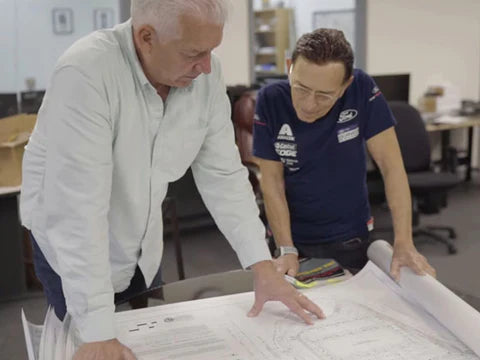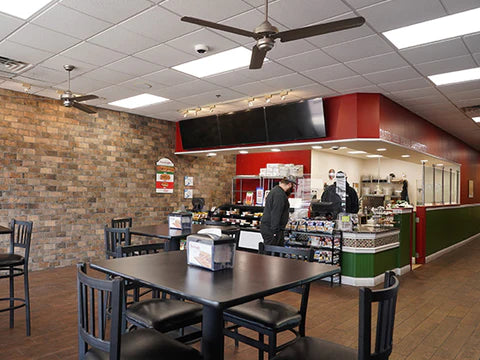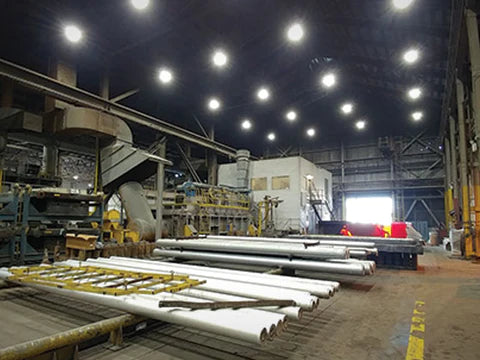Comparing LED Linear High Bay Quality Between Manufacturers
As you were growing up your father might have told you that you get what you pay for when you're shopping, and with the proliferation of online shopping, that's more than ever. Cheaper is not always better when it comes to quality and capability. With a quick glimpse at LED lights, it may be hard to see any differences other than price, so we'll break down three styles of Linear LED High Bays to show you some key features to look out for when shopping online for lights such as build quality, drivers, and installation costs.
1. Build Quality


With a quick glance, the above light looks fine—until you take a deeper look.


Notice the plastic diffuser on the edge of the panel.
The purpose of a diffuser is to evenly spread light... but this one is bent, which ruins the integrity of the diffuser.
When purchasing lights online, you expect to receive what you saw in the photos, but that's not always the case. Your lights could be damage during the shipping process if they're not properly packaged, or they could just have poor build quality. 

The crooked housing in the photos above jumped out at our quality control team.
You might even be surprised to open the box and see this:


Jagged screws protruding off the fixture stabbed holes in the box. If you're not off to the ER to fix the gash on your finger, you may also notice sloppy wiring, which is going to make it more difficult to install than it needs to be.

With ELEDLights Linear High Bays, build quality is never an issue. Our lights are constructed with a sturdy all-aluminum body and high-quality machine printed circuit boards for the LEDs. 
Each strip in our linear high bays has a thick plastic diffuser around it to protect it. The diffuser covers the entire surface area of the light, providing even light spread.
We provide thick, durable hanging wires that come ready to hang and install, making mounting this light a basic task.
Inside the light, you'll find everything is neat, with no extra wires. We also use a secure back to protect the driver. Speaking of drivers—that's another area where manufacturers like to cut corners.
2. Drivers
The driver is the main power source to the light. It regulates the power to an LED or a string of LEDs. If an error occurs in the driver, it will fail to power the light.
Bad driver = Bad light
A linear LED light fixture requires one driver to power the strips. Yet the light shown above is powered by 2 drivers—completely unnecessary. In this case, one of the drivers is powering 100W and the other 50W. This is on a 160W light, and the two-driver setup is going to lead to an overdriving failure. And if one of those two drivers were to fail, you'd be left with a half-lit light.
There's only one reason that a light would have two drivers, and that's because they used two cheap drivers. Better to have one expensive, reliable one.
With the rare exception of a stadium light, there's no reason to have more than one driver in a light. 

The 110W driver shown above looks okay... until you look what's on the inside. Look at that There's sloppy, crazy wiring. Many of these wires likely aren't even needed; they just slow down the installation process.
Also note that the driver cavity is filled with a black rubber insulator, which keeps heat from escaping. This light is at risk of driver overheating and early failure.
Above you can see the driver on our 120W Linear High Bay. We use a single, high-quality120W driver that evenly distributes power while also fitting the correct wattage. With the correct energy flowing through the light, it will reduce the risks of overpowering or burning out your light. ELEDLights drivers are designed to last you the minimum 50,000-hour lifespan that all our lights provide. We also offer 180W, 240W, and Ultra Bright 400W Linear High Bays.
Driver quality is essential to ensure the lifespan of your product. Since drivers are not visible and are the most expensive part of the light, this is where most companies cut corners.
But here's another facet to consider when selecting your lights:
3. Overall Install Costs
Buying the cheapest light online makes sense until you realize you're going to be spending even more money than you should have. If the cheap driver burns out or fails, you're going to have to pay the fee for having an electrician come out and replace the light. On average, electricians cost anywhere from $65-100 per hour. On top of that, the average costs to rent a lift is about $250 per day. TNot to mention the annoying interruption of having an electrician working over your head during work hours. Just do it right the first time and you won't have to worry about spending a hundreds of extra dollars re-doing it.
Wouldn't you rather put a little more money into getting a high quality, long lasting light—right out of the box? Our goal is to allow you to run your company, not fix lights.
The parent company of ELEDLights is Manncorp. Manncorp has been in business and operating for over 50 years producing and supplying machines that assemble circuit boards and place components for LEDs. Our engineers know exactly what to look for and are beyond critical of any product that we consider going through our testing process. ELEDLights' lighting is quality checked at the factory, packed securely for shipping, and backed up by a strong warranty.
You absolutely get what you pay for. For further information or any questions contact our office at 215.355.7200 (East) or 858.581.0597 (West) or check out our website!

 215.355.7200
215.355.7200




